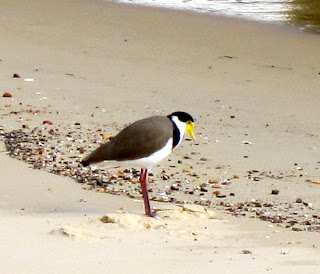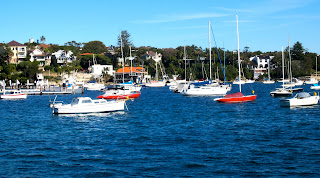Rose Bay to Watsons Bay: Gloomy skies gave way to brilliant sunshine and warmth today. We were met at the Rose Bay Wharf by Marguerite who led us along our route all the way to Watsons Bay for lunch followed by a quick look at the The Gap and then a cup of tea in her home. Marguerite knows the area well and we were absolutely delighted to have her along leading the way and providing so much information.A highlight, or one of them, today was the 1.8 kilometre Hermitage Foreshore Walk part of the Sydney Harbour National Park. No-one in our group had walked this portion of today's walk before thus a delightful new experience for all of us. The area is home to the last remnants of coastal bushland on the eastern harbour foreshore. We had spectacular views down the harbour to Shark Island, the city skyline, The Bridge and Opera House. Spectacular! After walking along the signposted track through gnarled tea trees we came upon the first little beach, Queens Beach, then on to the gracious old Strickland House (c 1856), now sadly quiet and empty. A huge flock of black cockatoos flew overhead.Every time we looked over left to the harbour we were presented with ever more stunning views. Onwards we went to Milk Beach with more peaceful bushland including paperbarks and stringy casuarinas before descending to Nielsen Park on Shark Beach. Coffee in the old sandstone kiosk before ambling alongside Vaucluse House with its well kept original style gardens.Through a few streets of Vaucluse before arriving at Watsons Bay for a relaxed lunch in the warm sunshine. As we had an hour before our return ferry Marguerite invited us to her home for a cup of tea after climbing the steps up to The Gap.Thank you Marguerite for a wonderful day - we started at 9.00 leaving Rose Bay at 2.00 p.m. A lovely day indeed.Walkers : Donna, Pippa, Marie-Claire, Jane, Carolle and of course Marguerite
Monday, 20 May 2013
Walk 39 - Rose Bay to Watsons Bay
Saturday, 11 May 2013
Walk 38 - Clifton Gardens/Zoo/Circuit
Clifton Gardens/Zoo Circuit: Once again sunny, pleasant weather for one of Sydney's great walks which afforded many outstanding views across the harbour to the city skyline as well as to the Opera House and the Bridge. It is a comfortable walk too with excellent board walks, shady soft tread underfoot, Parking at Clifton Gardens amused us as the meter rejected coins but once we had that covered we were ably led by Marie-Claire who knows that walk and the area very well indeed. Clear water, Moreton BayFigs, natural unspoilt bush, Bacino Cafe, school kids on the beach all helped to make a perfect walk.
(Bradleys Head was named after Lieutenant William Bradley of the First Fleet who surveyed the harbour in 1788 with Captain John Hunter)
quote
"There is a fine view from Bradley's Head. There is also a memorial to the four naval vessels which have borne the name H.M.A.S.Sydney and the mast from the first of these. This mast belonged to the light cruiser which, on 9th November 1914, engaged the German cruiser Emden near Cocos Island in the first naval engagement of the Great War (WWI) involving an Australian ship. Nearby is a stone column from the old Sydney Post Office which was used to measure a distance of precisely one nautical mile from the tower of Fort Denison."
Walkers: Marie-Claire, Moira, Pippa, Donna, Carolle
 |
| 30 Rooms in The Manor
quote - "The Manor is a mansion in the Sydney suburb of Mosman. Built circa 1911, loosely in the Federation Queen Anne style, it stands in the harbour-front street of Iluka Road, in the Mosman locality of Clifton Gardens. It is listed on the heritage register of New South Wales.[1]
[edit]History and description
The Manor's original owner, a Mr Bakewell, initially planned a cottage of eight rooms, but the project kept growing until it was a mansion with over thirty rooms, most of which were lined with beaten copper. It became known locally as Bakewell's Folly.[2] In 1922, the Theosophical Society rented The Manor for a community of some fifty people, headed by Charles Leadbeater, a claimed clairvoyant, and a major figure in the Society. The Manor became an important centre for the Society and was regarded as a great "occult forcing-house".[3]
The English writer Mary Lutyens stayed at The Manor in the 1920s and described it as "a huge and hideous villa".[4] The young Indian Jiddu Krishnamurti, who was presented as the new "World Teacher", stayed in nearby David Street with his brother Nitya while Lutyens—his eventual biographer—stayed at The Manor.[5]
The Theosophical Society bought the house in 1925, holding it under a trust deed. In 1926 they started the radio station 2GB; the initials stood for Giordano Bruno, a saint. The station operated from The Manor for a few years.[6] In 1951, they set up The Manor Foundation Ltd to own and run the house. The Society still uses The Manor as of 2013."
(Well what a surprise it was to learn from the above quote from the Internet that 2GB, a Sydney radio station that the initials GB stand for Giordano Bruno a saint who was burnt at the stake. At a meeting recently a couple of the walkers in this Walking Group and I listened to an interesting talk about this very man. Most people have never heard of him. None of us at that meeting certainly had no knowledge of him. Why I wonder is 2GB named for him?)
|
 |
| Bacino Cafe - Hole in the Wall |
Saturday, 4 May 2013
Walk 37 - Kokoda Memorial Track Walkway
While on the Kokoda Track Memorial Walkway we wondered who was responsible for this splendid memorial, who designed it, how were those wonderful granite walls achieved. The following random facts are now quoted below from sources on the Internet to save you looking them up later.
We had a leisurely walk following the 800 meters along the Memorial track itself but continued further on the Walkway going past the hospitals located at Concord West. We found the horse paddocks, the old gardens of Yaralla Estate, the house which is now being renovated. Please click on this link which is fascinating and very interesting and will answer some of the queries raised as we wandered around yesterday:
then the Memeorial Walkway itself:
"Features of the Memorial Walkway
Memorial Centrepiece
Rainforest Area
Designed by DM Taylor Landscape Architects Pty Ltd, the Kokoda Track Memorial Walkway has the following features:
Memorial Centrepiece
A striking series of granite walls on which images from the New Guinea Campaign have been sandblasted. Water also forms an integral part of the Centrepiece, with it cascading alongside the granite walls.
Rainforest Area
Includes a watercourse leading into a pond overlooking the Parramatta River.
The Kokoda Track Memorial Walkway is a unique tribute to the bravery of Australian troops who fought through atrocious conditions and against vastly superior enemy numbers in the Papua-New Guinea campaign of July 1942-January 1943. With US support the Australians inflicted on the Japanese Imperial Army its first defeat.
The fighting on The Kokoda Track was one of the vital elements which saved Australia from invasion in World War II. The Papua campaign, including The Kokoda Track, Milne Bay, Buna, Gona and Sanananda resulted in total Australian and United States casualties of 8546. Casualties from malaria were more than 27,000 and from tropical diseases at least 37,000. More than 2000 Australians and 600 Americans were killed. During the four months of fighting in the Owen Stanley Ranges the Australian infantry lost 607 killed and 1015 wounded.
The Kokoda Track Memorial Walkway covers more than 800 metres from Rhodes Station to Concord Hospital in Sydney's inner-west, and runs along the mangrove-studded shores of Brays Bay on the Parramatta River. At the centrepiece are magnificent granite walls bearing photographic images of the campaign; there are 22 stations or plaques along the walkway, each describing a significant place or engagement; the walkway has been planted with lush tropical vegetation simulating the conditions of The Kokoda Track.
On this site you will see and hear descriptions of the campaign, with photographs, interviews and maps; there are links to Oral Histories andWar Memorial sites; there is an Educational Resource section, aCalendar of annual events taking place at the Walkway, and a link to theFriends of Kokoda.
We hope you will enjoy this site and gain an appreciation of the sacrifices and achievements of the young Australians who gave so much in defence of their nation." | |
Subscribe to:
Comments (Atom)






























































